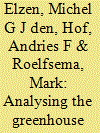|
|
|
Sort Order |
|
|
|
Items / Page
|
|
|
|
|
|
|
| Srl | Item |
| 1 |
ID:
121321


|
|
|
|
|
| Publication |
2013.
|
| Summary/Abstract |
As part of the Cancún Agreements, 45 non-Annex I countries have pledged mitigation action plans, of which 16 countries, including the seven major emitting countries, have submitted quantified mitigation actions. Many countries published their business-as-usual (BAU) emissions to which their pledges are connected. This study analyses the expected emission levels from the pledged, quantified actions, and whether these are consistent with achieving the 2 °C target. One of the main findings is that new BAU emission projections have led to about 2.5 GtCO2eq higher emission levels expected from pledges by non-Annex I countries. The emissions for non-Annex I countries as a group would be between 9% and 12% below our 2020 BAU emission projections, for, respectively, the unconditional and conditional pledges. This result might be conservative as we assume countries without quantified pledges follow BAU. This implies that for a medium chance of achieving 2 °C, Annex I countries would need to reduce its emissions by about 50% below 1990 levels by 2020. If Annex I countries as a whole would reduce emissions by 13% to 18% below 1990 levels, as expected from the pledges, the reduction of non-Annex I countries should be 22% to 34% below BAU levels for a medium chance of achieving 2 °C.
|
|
|
|
|
|
|
|
|
|
|
|
|
|
|
|
| 2 |
ID:
128441


|
|
|
|
|
| Publication |
2014.
|
| Summary/Abstract |
Many of the major greenhouse gas emitting countries have planned and/or implemented domestic mitigation policies, such as carbon taxes, feed-in tariffs, or standards. This study analyses whether the most effective national climate and energy policies are sufficient to stay on track for meeting the emission reduction proposals (pledges) that countries made for 2020. The analysis shows that domestic policies of India, China and Russia are projected to lead to lower emission levels than the pledged levels. Australia's and the EU's nationally legally binding policy framework is likely to deliver their unconditional pledges, but not the conditional ones. The situation is rather unclear for Japan, South Korea, Brazil and Indonesia. We project that policies of Canada and the USA will reduce 2020 emission levels, but additional policies are probably needed to deliver their pledges in full. The analysis also shows that countries are implementing policies or targets in various areas to a varying degree: all major countries have set renewable energy targets; many have recently implemented efficiency standards for cars, and new emission trading systems are emerging.
|
|
|
|
|
|
|
|
|
|
|
|
|
|
|
|
|
|
|
|
|